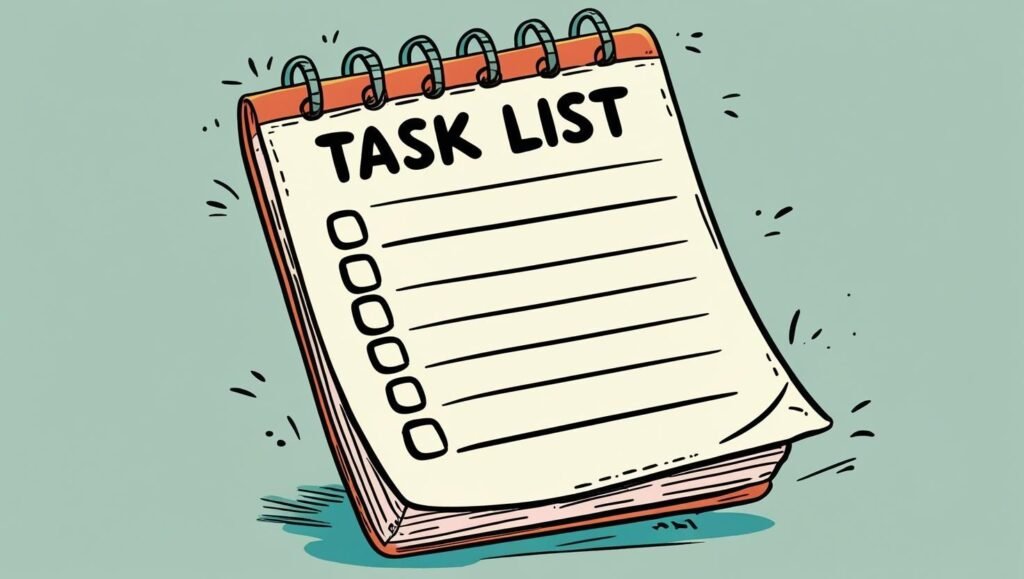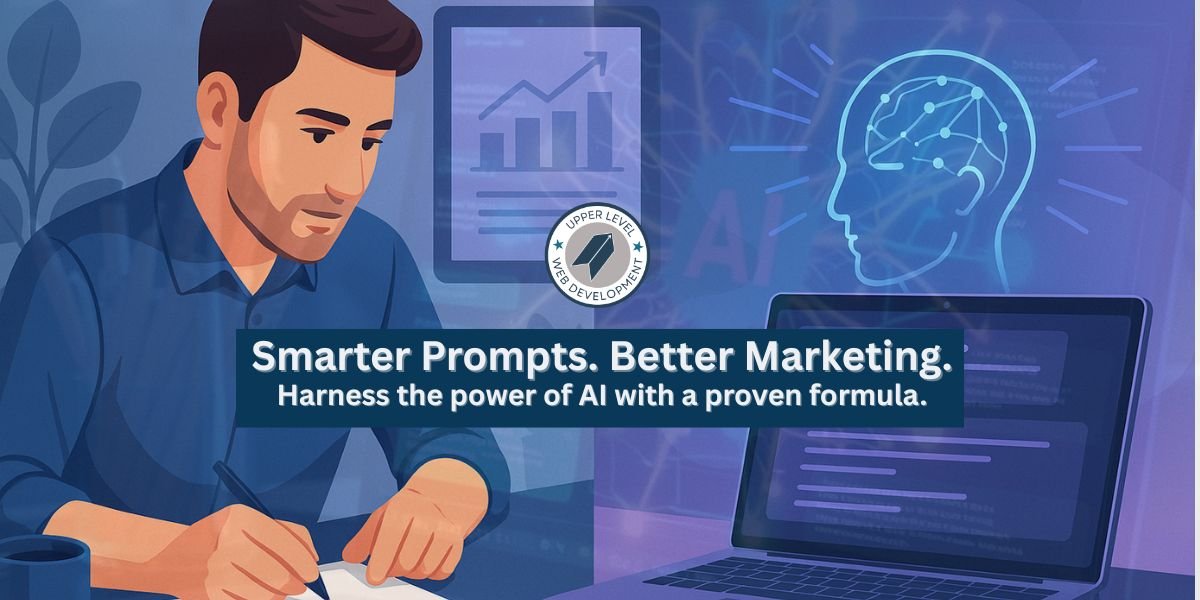How to Use ChatGPT for Marketing Your Business
Here’s Our Complete Formula That Works with ChatGPT, Gemini, Claude & More!
If you’re a business owner looking to grow your brand online, you’ve likely heard the buzz about using ChatGPT for marketing. But opening up the tool is one thing — knowing how to actually get results from it is something else entirely.
Maybe you’ve tried it before. You asked ChatGPT to write a blog post or generate a few social media ideas. And what you got… kind of worked. But it felt generic. It didn’t sound like your business. It didn’t connect with your audience. And most of all — it didn’t convert.
Here’s the truth: It’s not your fault. It’s your prompt.
AI is only as smart as the instructions you give it. That’s why we built a simple system that helps business owners and marketers get powerful, strategic content — without needing to be AI experts or marketing pros.
The Upper Level formula is this:
Role + Audience + Task = Better Results
We mention ChatGPT throughout this article because it’s the most commonly used AI platform today. But this system works across all GPT-based tools, including Google’s Gemini, Anthropic’s Claude, Mistral, and others. The structure is what matters — not the logo.
Let’s walk through it.
Step 1: Assign a Role

Start your prompt by telling the AI who it should act like. This sets the tone, expertise level, and strategic approach. You’re guiding the AI to think like a specialist — not a generalist.
Here are 10 role examples you can use depending on your content need:
- Act as a senior content strategist that specializes in creating content that is engaging, converts, and adds value to our audience…
- You are a brand strategist focused on building meaningful, differentiated brand identities that connect emotionally with target audiences…
- Act as a social media manager who knows how to drive engagement, build community, and grow brand awareness through consistent and creative content…
- You’re a direct response copywriter with expertise in crafting persuasive, action-oriented messaging that drives conversions across digital channels…
- Act as an email marketing specialist skilled in writing sequences that nurture leads, increase retention, and feel personal — not salesy…
- You’re a digital marketing analyst who translates complex data into actionable insights that help optimize campaigns and drive measurable growth…
- Act as a paid ads manager who builds ROI-driven ad strategies across platforms like Google, Meta, and LinkedIn with clear audience targeting and A/B testing…
- You are a communications director experienced in shaping narratives, handling media outreach, and delivering consistent messaging across all stakeholder touchpoints…
- Act as an SEO specialist who improves organic visibility through smart keyword strategies, on-page optimization, and a content-first approach…
- You’re a creative director who leads concept development and visual storytelling to create cohesive, high-impact campaigns across all marketing channels…
Step 2: Define the Audience

Next, tell the AI who you’re talking to. This helps shape the message in a way that resonates with your actual customers — not just some generic internet crowd.
Here are 20 detailed audience types to choose from:
- …to connect with small business owners who wear multiple hats and need marketing that’s practical, fast, and budget-conscious…
- …to connect with mid-size company decision-makers who are focused on scaling and value ROI-driven solutions with proven results…
- …to connect with local consumers who prioritize trust, personal connection, and proximity when choosing where to shop or who to hire…
- …to connect with national brand buyers who expect consistency, professionalism, and an elevated digital experience across all touchpoints…
- …to connect with service-based business owners looking for ways to attract clients online without sounding too salesy…
- …to connect with product-focused businesses that need to explain features while highlighting the emotional benefits of ownership…
- …to connect with digital-first audiences who expect speed, personalization, and a modern user experience across all platforms…
- …to connect with skeptical buyers who’ve been burned before and need clear proof, social proof, or guarantees before committing…
- …to connect with Gen Z consumers who value authenticity, bold aesthetics, and brands that align with their personal identity…
- …to connect with Millennials who appreciate convenience, transparency, and storytelling that reflects real-life challenges…
- …to connect with Gen X professionals who value efficiency, practicality, and expert-level communication that respects their time…
- …to connect with Baby Boomer audiences who may not be digital natives but are highly loyal once trust is earned…
- …to connect with tech-savvy users who prefer to explore, compare, and test before ever speaking to a sales rep…
- …to connect with DIY-minded entrepreneurs who want to be empowered with tools, templates, and guidance — not just buzzwords…
- …to connect with early-stage startups who are still refining their offer and need clarity in how they’re positioned to investors and users…
- …to connect with corporate buyers who respond to data-driven logic, KPIs, and brand credibility over hype…
- …to connect with parents of young children looking for products and services that are safe, helpful, and time-saving…
- …to connect with eco-conscious consumers who actively seek sustainable, ethical alternatives to mass-market options…
- …to connect with remote workers and freelancers who value flexibility, automation, and clear value from digital products and services…
- …to connect with community-driven audiences who support brands that give back, get involved locally, or highlight customer stories…
Step 3: Be Clear About the Task

The final step is simple but crucial: Tell ChatGPT exactly what you want. That includes the format, tone, and goal. This turns generic AI output into business-ready content.
Here are 10 task prompts you can plug into your next request:
- Create a blog post of 750–1000 words. Give it a compelling headline and suggest keywords based on my business. Write in a human voice, avoid jargon, and focus on providing real value. Skip unnecessary formatting like emojis or excessive headings.
- Write an email campaign consisting of 3 emails. Each email should build on the previous one, with clear subject lines and one focused CTA. Tone should be conversational and informative, not salesy.
- Draft a high-converting landing page that introduces my product or service to new customers. Include a headline, subheadline, key benefits, a customer testimonial, and a clear CTA — no fluff.
- Create 5 social media post captions designed to spark conversation and engagement. Avoid generic tips — each post should offer something original, helpful, or thought-provoking.
- Build a 3-part video script series to promote a service or product launch. Each script should be under 90 seconds, with a strong hook, core message, and natural CTA. Keep the language sharp, real, and platform-appropriate.
- Write a LinkedIn post designed to build authority on a topic relevant to my audience. Keep it under 300 words, lead with a bold or relatable insight, and end with a question or call to engage. No hashtags overload.
- Create an SEO-optimized blog outline with a working title, suggested headings, target keywords, and a one-sentence goal for each section. Prioritize readability and real usefulness over keyword stuffing.
- Write a YouTube video script for a 2–3 minute explainer video. The script should open with a strong hook, walk through a clear structure, and end with a soft CTA. Make it conversational and visually engaging.
- Develop a LinkedIn carousel post idea with 7 slides. Include the text for each slide, a title, and direction for visuals or layout. Make it professional but approachable, and focused on one clear takeaway.
- Generate a list of long-tail SEO keywords related to my product or service. Group them by intent (informational, navigational, transactional) and suggest how each could be used in future content.
Step Four: Choose One of Each and Tailor to Your Specifics

Once you understand the structure, the real power comes from mixing and matching based on your business needs. Here’s how to do it:
- Pick a Role (Who the AI should act as)
- Pick an Audience (Who the content is for)
- Pick a Task (What you want the AI to create)
Put all three together into a single prompt — and you’ve got an AI-powered creative brief that gets results.
Full Example Prompt:
Act as a senior content strategist that specializes in creating content that is engaging, converts, and adds value to our audience. Write a blog post to connect with small business owners who wear multiple hats and need marketing that’s practical, fast, and budget-conscious. Create a blog post of 750–1000 words. Give it a compelling headline and suggest keywords based on my business. Write in a human voice, avoid jargon, and skip unnecessary formatting like emojis or excessive headings.
Why This Works — No Matter Which AI You Use
This prompt formula isn’t tied to any one platform. Whether you’re using ChatGPT, Gemini, Claude, or any other AI assistant, this structure tells the model:
- Who to act as
- Who the message is for
- What to produce and how to produce it
It works because it gives the model clarity, context, and purpose. That’s the difference between content that needs hours of editing — and content you can copy, paste, and publish.
Coming Soon: A Full Course on Prompting for Business Owners
We’re building a full course designed for business owners who want to get more out of AI — without sounding like everyone else online. You’ll learn how to use this exact prompt structure across email, web, social, and search… and how to build a custom prompt library that works for your brand.
Want first access? Make sure you’re on our list — or reach out to us directly to reserve your seat.
Want a Smarter Website Too?
If you’re putting in the work to create better content, your website should be ready to support it. At Upper Level Development, we specialize in building fast, strategic WordPress websites that turn visitors into leads and content into conversions.
- Custom WordPress Design & Development
- SEO & Performance Optimization
- Content Strategy Integration
- Support for Small and Mid-Sized Business Growth
Let’s make your website and your content work together.

